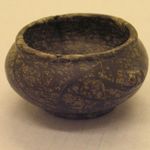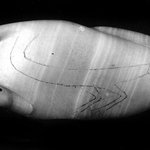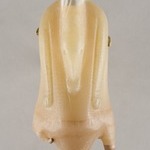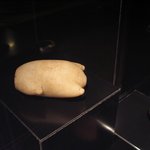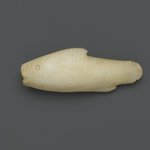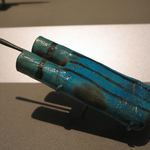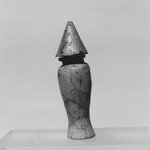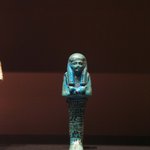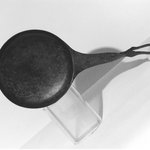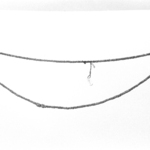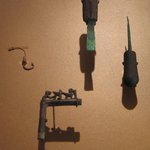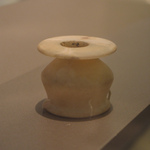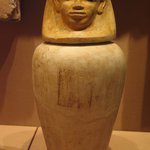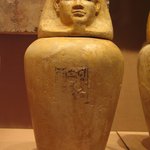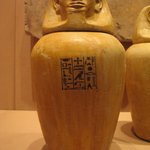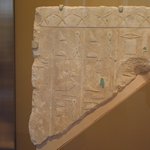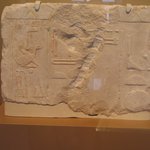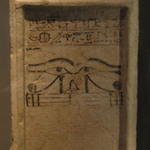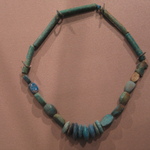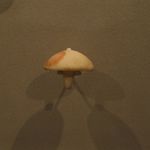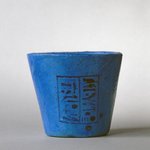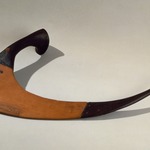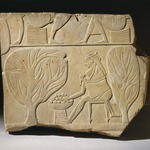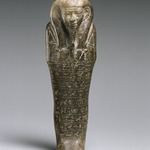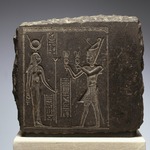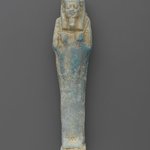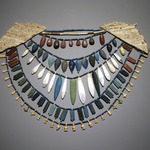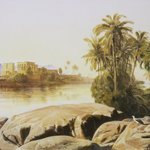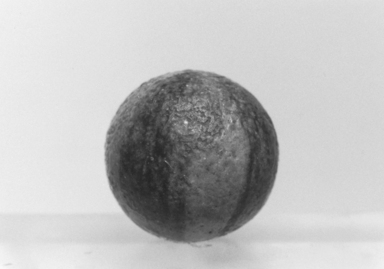
Ball with Internal Pellets
Egyptian, Classical, Ancient Near Eastern Art
On View: Egyptian Orientation Gallery, 3rd Floor
Faience
An Egyptian invention, faience first appeared about 3500 B.C.E. and was used for a range of objects, including jewelry, amulets, bowls, pots, statuettes, inlays, and gaming pieces.
To make faience, ancient artisans first molded or shaped the raw material—a glassy paste of crushed quartz or sand —and then fired it. Craftsmen glazed faience pieces in three different ways. The simplest and oldest method involved brushing the object with, or immersing it in, liquid glaze before firing. Alternatively, workers mixed a crystalline mineral salt with the faience and allowed it to evaporate to the surface while the object dried. This mineral salt then melted and fused into a glaze during firing. In the third technique, an artisan buried the object in a glazing powder that fused with the core during firing. To decorate faience objects, craftsmen painted on designs before firing or mixed the moist faience paste with mineral colorants.
Unlike faience, glass was a foreign import that arrived in Egypt from western Asia shortly before 1500 B.C.E. The first Egyptian glassmakers relied on molds, limiting production to small objects such as beads and amulets. Later craftsmen perfected techniques that allowed for large, complex pieces.
Recreational Objects
The Egyptians were fascinated by faience’s bright colors and lustrous finish, and fashioned a wide variety of recreational objects in the material.
The hollow faience ball in this case—too fragile to have been tossed—probably served as a rattle during musical performances or religious rituals. The charming object in the form of an ape was a playing piece in one of the many Egyptian board games.
An Egyptian invention, faience first appeared about 3500 B.C.E. and was used for a range of objects, including jewelry, amulets, bowls, pots, statuettes, inlays, and gaming pieces.
To make faience, ancient artisans first molded or shaped the raw material—a glassy paste of crushed quartz or sand —and then fired it. Craftsmen glazed faience pieces in three different ways. The simplest and oldest method involved brushing the object with, or immersing it in, liquid glaze before firing. Alternatively, workers mixed a crystalline mineral salt with the faience and allowed it to evaporate to the surface while the object dried. This mineral salt then melted and fused into a glaze during firing. In the third technique, an artisan buried the object in a glazing powder that fused with the core during firing. To decorate faience objects, craftsmen painted on designs before firing or mixed the moist faience paste with mineral colorants.
Unlike faience, glass was a foreign import that arrived in Egypt from western Asia shortly before 1500 B.C.E. The first Egyptian glassmakers relied on molds, limiting production to small objects such as beads and amulets. Later craftsmen perfected techniques that allowed for large, complex pieces.
Recreational Objects
The Egyptians were fascinated by faience’s bright colors and lustrous finish, and fashioned a wide variety of recreational objects in the material.
The hollow faience ball in this case—too fragile to have been tossed—probably served as a rattle during musical performances or religious rituals. The charming object in the form of an ape was a playing piece in one of the many Egyptian board games.
MEDIUM
Faience
DATES
ca. 1539–1292 B.C.E.
DYNASTY
Dynasty 18
PERIOD
New Kingdom
DIMENSIONS
1 1/4 x Diam. 1 1/4 in. (3.2 x 3.1 cm) (show scale)



COLLECTIONS
Egyptian, Classical, Ancient Near Eastern Art
ACCESSION NUMBER
09.879
CREDIT LINE
Museum Collection Fund
PROVENANCE
Archaeological provenance not yet documented; before 1909, acquired, possibly in Egypt, by Sarah Munn Pier (Mrs. Garrett Ryckman Pier) of New York, NY; November 18, 1909, purchased at The American Art Galleries, New York, “Rare and Beautiful Antique Treasures collected by Mrs. Garrett Ryckman Pier,” lot 632, by the Brooklyn Museum.
Provenance FAQ
EXHIBITIONS
MUSEUM LOCATION
This item is on view in Egyptian Orientation Gallery, 3rd Floor
CAPTION
Ball with Internal Pellets, ca. 1539–1292 B.C.E. Faience, 1 1/4 x Diam. 1 1/4 in. (3.2 x 3.1 cm). Brooklyn Museum, Museum Collection Fund, 09.879. Creative Commons-BY (Photo: Brooklyn Museum, CUR.09.879_NegL1006_22_print_bw.jpg)
IMAGE
overall, CUR.09.879_NegL1006_22_print_bw.jpg. Brooklyn Museum photograph, 2014
"CUR" at the beginning of an image file name means that the image was created by a curatorial staff member. These study images may be digital point-and-shoot photographs, when we don\'t yet have high-quality studio photography, or they may be scans of older negatives, slides, or photographic prints, providing historical documentation of the object.
RIGHTS STATEMENT
Creative Commons-BY
You may download and use Brooklyn Museum images of this three-dimensional work in accordance with a Creative Commons license. Fair use, as understood under the United States Copyright Act, may also apply.
Please include caption information from this page and credit the Brooklyn Museum. If you need a high resolution file, please fill out our online application form (charges apply).
For further information about copyright, we recommend resources at the United States Library of Congress, Cornell University, Copyright and Cultural Institutions: Guidelines for U.S. Libraries, Archives, and Museums, and Copyright Watch.
For more information about the Museum's rights project, including how rights types are assigned, please see our blog posts on copyright.
If you have any information regarding this work and rights to it, please contact copyright@brooklynmuseum.org.
RECORD COMPLETENESS
Not every record you will find here is complete. More information is available for some works than for others, and some entries have been updated more recently. Records are frequently reviewed and revised, and we welcome any additional information you might have.

